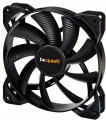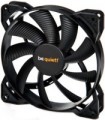Min. RPM
The lowest speed at which the cooling fan is capable of operating. Specified only for models with speed control (see below).
The lower the minimum speed (with the same maximum) — the wider the speed control range and the more you can slow down the fan when high performance is not needed (such a slowdown allows you to reduce energy consumption and noise level). On the other hand, an extensive range affects the cost accordingly.
Speed controller
—
Auto (PWM). A type of automatic regulator used in processor cooling systems. The principle of this adjustment is that the automation monitors the current load on the CPU and adjusts the fan operation mode to it. Thus, the cooling system works "in advance": it actually prevents the temperature rise, and does not eliminate it (unlike the thermostat described below). The disadvantages of such automation are the high cost and additional compatibility requirements: the PWM function must be supported by the motherboard, and the fan must be powered through a 4-pin connector (see "Power").
— Manual. Manual regulator that allows you to set the rotation speed at the request of the user. Its main advantages are both the possibility of arbitrary adjustment and reliability: automation does not always respond optimally, and in performant systems it is sometimes better for the user to take control into his own hands. On the other hand, manual control is more expensive and also more difficult to use — it requires the user to pay more attention to the state of the system, and if not attentive, the likelihood of overheating increases significantly.
— Manual / auto. A combination of the two systems described above: the main control is carried out by PWM, and the manual regulator serves to limit the maximum rotational speed. A fairly convenient and advanced option that expands the possibilities of auto-adjustment and at the same time doe
...s not require constant temperature control, as with a purely manual setting. However such functionality is expensive.
— Adapter (resistor). In this case, the speed is adjusted by reducing the voltage supplied to the fan. To do this, it is connected to the power supply through a resistor adapter. This is a kind of alternative to manual adjustment: adapters are inexpensive. On the other hand, they are much less convenient: the only way to change the rotation speed with such an adjustment is to actually change the adapter, and for this you have to turn off the system and climb into the case.
— Thermostat. Automatic speed control according to data from a sensor that measures the temperature of the cooled component: when the temperature rises, the intensity of work also increases, and vice versa. Such systems are simpler than the PWMs described above, moreover, they can be used for almost any system component, not only for CPU. On the other hand, they have more inertia and reaction time: if the PWM prevents heating in advance, then the thermostat is triggered by an increase in temperature that has already happened.Noise level
The standard noise level generated by the cooling system during operation. Usually, this paragraph indicates the maximum noise during normal operation, without overloads and other "extreme".
Note that the noise level is indicated in decibels, and this is a non-linear value. So it is easiest to evaluate the actual loudness using comparative tables. Here is a table for values found in modern cooling systems:
20 dB — barely audible sound (quiet whisper of a person at a distance of about 1 m, sound background in an open field outside the city in calm weather);
25 dB — very quiet (normal whisper at a distance of 1 m);
30 dB — quiet (wall clock). It is this noise that, according to sanitary standards, is the maximum allowable for constant sound sources at night (from 23.00 to 07.00). This means that if the computer is planned to sit at night, it is desirable that the volume of the cooling system does not exceed this value.
35 dB — conversation in an undertone, sound background in a quiet library;
40 dB — conversation, relatively quiet, but already in full voice. The maximum permissible noise level for residential premises in the daytime, from 7.00 to 23.00, according to sanitary standards. However, even the noisiest cooling systems usually do not reach this indicator, the maximum for such equipment is about 38 – 39 dB.
Power source
Type of power connector for the cooling system. Power is usually output through the motherboard, for this the following connectors are most often used:
—
3-pin. Three-pin connector; Today it is considered obsolete, but it is still widely used.
—
4-pin. Plug with 4 pins. Its main advantage is the ability to automatically adjust the rotation speed via PWM (for more details, see "Speed controller").
These two standards are mutually compatible: a 3-pin fan can be connected to a 4-pin connector on the motherboard, and vice versa (unless PWM is available in both cases).
Much less common are options such as 2-pin, installed in some inexpensive fans;
6-pin, used in cooling systems with RGB backlighting, which requires a rather powerful additional power supply; 7-pin and 8-pin, similar in their specifics to a 6-pin connector; as well as power supply via a standard
MOLEX plug provided in separate case fans.

